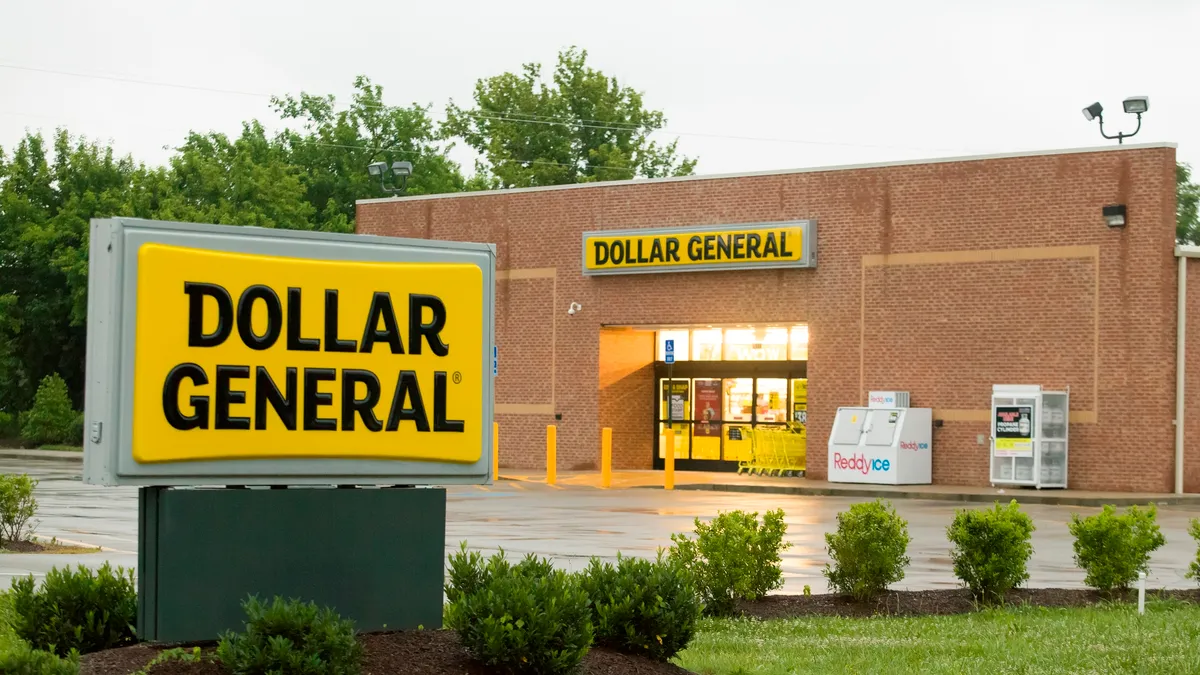Dive Brief:
- Dollar General has been pleased with sales of produce in around 200 stores and could add fresh fruits and vegetables to “thousands” of locations over time, CEO Todd Vasos during the company’s earnings call yesterday.
- Dollar General also is capitalizing on healthy snacking with a recently launched private label, Good & Smart. The line will eventually include 130 products and will comprise 75% of Dollar General’s better-for-you offerings, Vasos noted. “Our goal is to build Good & Smart into a unique private brand that becomes a go-to-product line for our customers when they look for good food choices at smart prices.”
- Dollar General reported net sales of $6.1 billion for the first fiscal quarter, a 9% increase over the year-ago period. Same-store sales increased 2.1% while earnings increased 33% to $1.36 per share. Traffic was down for the quarter, which executives attributed to inclement weather.
Dive Insight:
Dollar General operates close to 15,000 stores, so adding produce to thousands of locations would cover just a fraction of its overall footprint. Still, this could have a massive impact on retailers across the country — particularly independent retailers, which are oftentimes Dollar General’s only competitors in the many rural communities where it operates. According to research from Kansas State University, small-town grocers can lose as much as 30% of their sales when a Dollar General store opens nearby.
The discount retailer added produce to 45 stores during this most recent quarter, with plans to expand to 450 by the end of this year. Overall, Dollar General will remodel 1,000 stores this year, with 400 following the chain’s “traditional plus” format, which includes more grocery offerings and coolers for perishable items.
Produce is certainly at odds with Dollar General’s legacy product mix, which includes assorted nonfood items along with consumables like snacks and beauty care products. But the company likes produce and grocery products because they drive regular traffic, and because it sees an opportunity to compete with other food retailers on price and quality. Dollar General sees a 10% to 15% comp sales lift from its “traditional plus” store remodels, a third of which are stocking produce.
“We see [produce] as a competitive advantage, especially in rural areas where there isn't a lot of competition and/or food choices, especially healthy food choices for our core consumers,” Vasos said during yesterday’s conference call.
It’s far from a sure bet, however, that produce will become a widespread initiative for Dollar General. Fresh fruits and vegetables are expensive and difficult to manage, with a high risk for wasted product if not handled and merchandised just right.
What’s more of a sure bet for Dollar General is its expanded assortment of snacks, frozen and shelf-stable foods. Better-for-you offerings have become a bigger focus for the company, and its newly released Good & Smart line is expected to drive sales here. The line includes dried fruit, coconut water and other selections, and could become habit-forming selections for shoppers.
To drive impulse sales of these and other snack items, Dollar General has rolled out enhanced checkout lanes designed to spur impulse purchases. The company currently has these lanes in 6,000 stores and will expand to 7,000 by the end of this year. Dollar General is also adding more coolers across its store formats, with 20,000 expected to be in place chainwide by the end of this year, compared to 10,000 back in 2012.
The company is also trying to make shopping easier through its app, DG Go, which offers a scan-and-go functionality similar to what other retailers have. The long-term popularity of this function remains in question, with Walmart having recently axed its scan-and-go app, but Dollar General hopes to add more bells and whistles over time to personalize the experience for its customers.
Rather than taking a one-size-fits all approach, Dollar General is adding grocery and produce offerings in stores where it makes sense to do so. The company’s foot traffic declined this quarter — mainly due to inclement weather, according to company officials — but the growing focus on grocery should bump up traffic volumes and, most importantly, put more pressure on dedicated food retailers nationwide.










